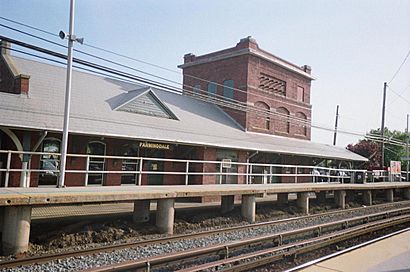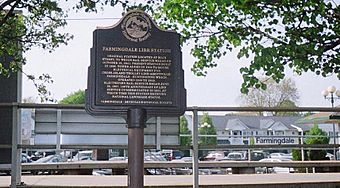Farmingdale station facts for kids
Farmingdale is a historic train station in Farmingdale, New York. It is part of the Long Island Rail Road's Main Line, which is also known as the Ronkonkoma Branch. The station is located on South Front Street and Atlantic Avenue, just east of Secatogue Avenue.
The station has two platforms, one on the north side and one on the south side. An underground walkway connects these platforms, making it easy to get from one side to the other. The main station building is on the south platform. You can find parking on both sides of the tracks. Farmingdale Station is about 32 miles (51 kilometers) east of Penn Station in New York City. The trip to or from Penn Station usually takes about 55 minutes. Some trains even start or end their journeys here.
Quick facts for kids
Farmingdale
|
|||||||||||||||
|---|---|---|---|---|---|---|---|---|---|---|---|---|---|---|---|

View of the historic Farmingdale Station in Farmingdale, New York, prior to its 2010s restoration, as seen from the north platform.
|
|||||||||||||||
| Location | Off Secatogue Avenue, on Front Street & Atlantic Avenue Farmingdale, NY |
||||||||||||||
| Owned by | Long Island Rail Road | ||||||||||||||
| Line(s) | Main Line | ||||||||||||||
| Platforms | 2 side platforms | ||||||||||||||
| Tracks | 2 | ||||||||||||||
| Connections | |||||||||||||||
| Construction | |||||||||||||||
| Parking | Yes; Village Permit and Metered | ||||||||||||||
| Bicycle facilities | Yes; Bike Rack | ||||||||||||||
| Disabled access | Yes | ||||||||||||||
| Other information | |||||||||||||||
| Fare zone | 7 | ||||||||||||||
| History | |||||||||||||||
| Opened | October 15, 1841 | ||||||||||||||
| Rebuilt | 1875, 1890, 2018 | ||||||||||||||
| Electrified | 1987 750 V (DC) third rail |
||||||||||||||
| Traffic | |||||||||||||||
| Passengers (2006) | 4,625 | ||||||||||||||
| Services | |||||||||||||||
|
|||||||||||||||
|
|||||||||||||||
|
Farmingdale Railroad Station
|
|||||||||||||||

Farmingdale Station's Historical marker.
|
|||||||||||||||
| Location | Farmingdale, New York, USA | ||||||||||||||
| Built | 1890 | ||||||||||||||
| Architectural style | Queen Anne | ||||||||||||||
| NRHP reference No. | 91001677 | ||||||||||||||
| Added to NRHP | November 13, 1991 | ||||||||||||||
Station History
Farmingdale station first opened on October 15, 1841. This was when the Long Island Rail Road began running trains through the village. The station building was rebuilt two times, first in July 1875 and again in 1890.
Between 1908 and 1909, an electric power station was added nearby. This helped power the Huntington Railroad. In June 1987, the station officially started using electric trains. This was part of a project to electrify the Ronkonkoma line.
On November 13, 1991, Farmingdale Station was added to the National Register of Historic Places. This means it is recognized as an important historical site. In 1996, money from the government was used to help restore the station building.
The station played a special role during the 2002 and 2009 US Open golf tournaments. These events were held at Bethpage State Park. Many golf fans used Farmingdale station to catch shuttle buses to the golf course. In 2009, almost 30% of all people who attended the tournament arrived by train.
Station Layout
Farmingdale station has two "high-level" platforms. This means the platforms are at the same height as the train doors, making it easy to get on and off. Each platform is long enough for 12 train cars.
Trains heading west usually use Platform A. Trains heading east typically use Platform B. However, some trains during the week might stop at the opposite platform. Farmingdale is also the last stop for some eastbound trains on weekdays.
You can park your car on both sides of the train tracks. If you live in the Village of Farmingdale, you can get a special permit. If you don't have a permit, you can pay at parking meters. On weekends, you don't need to pay for parking at the meters. There is also another parking lot west of the station along Front Street. This lot also requires a village permit.
- Farmingdale – LIRR
- Farmingdale LIRR timetable
- Unofficial LIRR History Website



